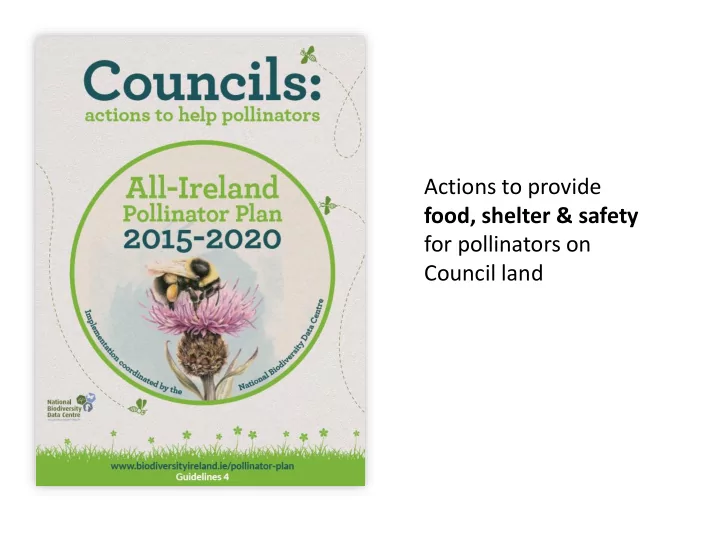

Actions to provide food, shelter & safety for pollinators on Council land
COUNCILS: actions to help pollinators A. Identify and protect existing areas that are good for pollinators Waterford Action 1 : Promote the management and restoration of semi-natural habitats Waterford and their native plants on council land Waterford
COUNCILS: actions to help pollinators A. Identify and protect existing areas Waterford that are good for pollinators Action 2 : Identify and protect existing sources of food and shelter for pollinators on Waterford general council land ✓ Flowering hedgerows (food) ✓ Patches of wildflowers on waste ground (food) ✓ Small wild areas with bramble/ivy (food) ✓ Existing earth banks (shelter) DON’T REPLACE ✓ Dry stone walls (shelter) SOMETHING GOOD Waterford WITH SOMETHING THAT IS ONLY OK…
B. Alter the frequency of mowing of grassy areas to allow more native plants to flower Action 3 : At least 10 locations mown under a pollinator friendly regime (5 cut & lifts per year)
B. Alter the frequency of mowing of grassy areas to allow more native plants to flower Action 4 : At least 5 meadows (one cut and lift per year) Waterford
B. Alter the frequency of mowing of grassy areas to allow more native plants to flower Action 5 : 10 flagship roadside verges that are managed to be pollinator Action 6 : friendly (one cut and lift per year) Introduce a layered mowing approach to other roadside verges
Don’t Mow Let it Grow - not cutting grass so often is the best and cheapest way to provide more food for pollinators Cut once a year – food and shelter Cut regularly Cut on a 6-weekly rotation from mid April - food Liam Scott
B. Pollinator-friendly mowing Waterford Waterford
C. Pollinator-friendly planting FOOD Action 7 : Plant a native wildflower meadow. Source native seed from Ireland and ensure that you plant pollinator-friendly species. This is difficult and can be costly Bees will be just as happy with natural regeneration
C. Pollinator-friendly planting Action 8 : Plant a native flowering hedgerow Traditional management of hedgerows on public land is often not pollinator friendly. If Council hedgerows are not in flower in April-May, they are not good for pollinators and other wildlife. FOOD
C. Pollinator-friendly planting Action 9: Replace grass with a dense clover sward FOOD
C. Pollinator-friendly planting Action 10: For future ornamental FOOD tree planting select from pollinator- friendly species List of ‘ Street trees ’ and ‘ Open Space ’ trees in appendix in Council guidelines. Examples: Open Space: Street Trees: Willow Juneberry Lime Upright Hawthorn Rowan Pillar Crab Wild Cherry Callery Pear Bird Cherry Rowan Apple Lime Horse chestnut Juneberry Indian Bean Tree Foxglove Tree Japanese flowering cherry Tom Cuffe
C. Pollinator friendly planting FOOD Action 11: For new works ensure 75% of ornamental NOT GOOD FOR planting is pollinator friendly POLLINATORS Action 12: In future ornamental maintenance planting, select pollinator- friendly species Action 13: Make some urban planters pollinator friendly Peter Cuthbert Very gaudy annuals like Geranium, Begonia, Busy Lizzy, Primula, Daffodil, Tulip, Salvia splendens don’t provide food
This might look good to us, but provides no food for pollinators
C. Pollinator-friendly planting FOOD
C. Pollinator-friendly planting FOOD Peter Cuthbert Peter Cuthbert Action 14: Pollinator-friendly roundabouts. Some roundabouts planted in a pollinator-friendly way with bulbs or pollinator-friendly perennials
D: Provide wild pollinator nesting habitat: hedgerows, earth banks and hotels *62 mining solitary bee species in Ireland Action 15 : Manage hedgerows for pollinators Action 16 : Bare earth/sand banks for wild pollinator nesting
D: Provide wild pollinator nesting habitat: hedgerows, earth banks and hotels *15 cavity- Action 18 : Bee hotels for wild nesting solitary pollinators bee species in Ireland A number of small hotels is better than one large one in terms of minimising the risks of disease Action 17 : Holes in wood or and predators concrete for wild pollinator killing the bees. nesting * Bee hotels can be useful and are a good awareness raising tool, but actions 16 and 17 are preferable ways to create nest sites. BIG ISN’T BETTER!
E. Reduce the use of pesticides Action 19 : Reduce or eliminate the use of pesticides Action 20 : Ensure best practice the use of pesticides cannot be avoided ✓ Aim to eliminate in some locations Waterford ✓ Turf - spray only sports pitches, bowling greens, cricket squares ✓ Adopt a policy of not spraying paths until the 15th April ✓ Have spraying buffer zones around important pollinator habitat ✓ Adopt the Pesticide Best Practice Code
F: Raise public awareness of pollinators within the local area • City, County or Local Development Plans Action 21 : Build actions on pollinators • Sustainability criteria of the Green Flag into existing frameworks and initiatives Award Scheme (parks) • Green Infrastructure strategies • Climate adaptation plans Action 23 : Put up Action 22 : Fund pollinator projects on council signage to identify land to demonstrate best practice to other pollinator-friendly sectors habitats on council land
F: Raise public awareness of pollinators within the local area Action 24 : Print & distribute pollinator-friendly guidelines to other sectors Action 25 : Promote & distribute the Junior Pollinator Plan to local schools Action 26 : Facilitate or deliver training on pollinators and how to take action to protect them
F: Raise public awareness of pollinators within the local area Action 27 : Fund pollinator award in the Tidy Towns or Ulster in Bloom competition Action 28 : Promote and get involved in other pollinator related initiatives Kildare County Council & Wicklow County Council supported animation
G. Tracking progress and recognition for efforts Action 29: Log your ‘Actions for Pollinators’ on the mapping system to ensure your efforts are recognised
G. Tracking progress and recognition for efforts Action 30: Take part in the Bumblebee Monitoring Scheme
CALL TO ACTION www.pollinators.ie Tom Cuffe Zoe Devlin polinators@biodiversityireland.ie Many thanks to all those who have donated images to the All-Ireland Pollinator Plan. Thank you
Recommend
More recommend